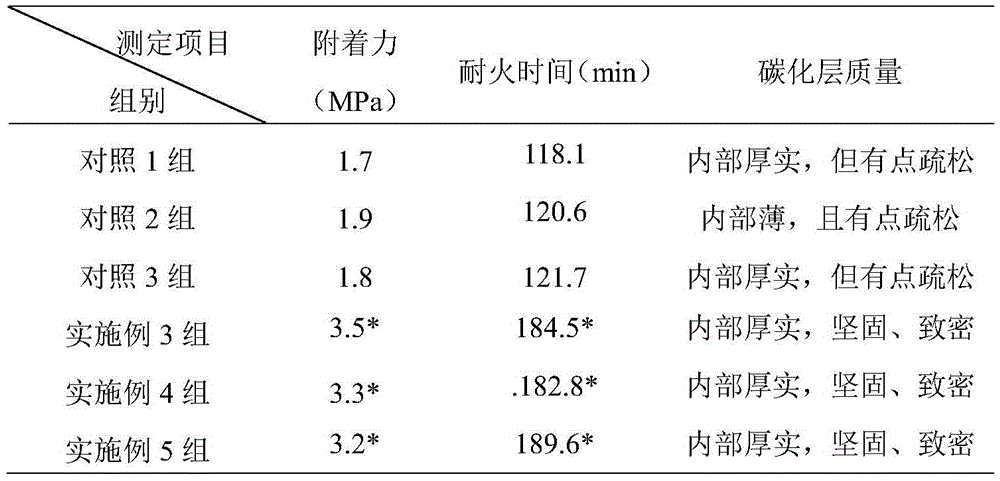A kind of flame-retardant plastic coating and preparation method thereof
A technology for flame-retardant plastics and coatings, applied in fire-resistant coatings, polyester coatings, coatings, etc., can solve the problems of insufficient coating adhesion, short service life, poor flame-retardant performance, etc., and achieve low cost, excellent adhesion performance, The effect of simple process
- Summary
- Abstract
- Description
- Claims
- Application Information
AI Technical Summary
Problems solved by technology
Method used
Image
Examples
Embodiment 1
[0018] Party:
[0019] 20g water-based acrylic resin, 10g polystyrene, 2g polylactate, 4g zinc stearate, 1g sodium lauryl sulfonate, 2g dibutyl phthalate, 6g pentaerythritol, 0.5g pigment, 1g talcum powder .
[0020] Preparation:
[0021] (1) Put polystyrene and polylactate in a container, add sodium dodecylsulfonate and a certain amount of deionized water, disperse at a high speed of 4000r / min for 30 minutes, and obtain the first emulsion;
[0022] (2) Add zinc stearate, dibutyl phthalate, pentaerythritol and pigments to the above-mentioned primary emulsion, and disperse at a high speed of 3600r / min for 20 minutes to obtain a color slurry;
[0023] (3) Mix water-based acrylic resin, talcum powder and the above-mentioned color paste, disperse at a low speed of 800r / min for 10 minutes, and the product is obtained.
[0024] The degree of polycondensation of the water-based acrylic resin is 40.
Embodiment 2
[0026] Party:
[0027] Water-based acrylic resin 20g, polystyrene 20g, polylactate 12g, zinc stearate 10g, sodium lauryl sulfonate 5g, dibutyl phthalate 8g, pentaerythritol 12g, pigment 0.9g, glass powder 7g .
[0028] Preparation:
[0029] (1) Put polystyrene and polylactate in a container, add sodium dodecylsulfonate and a certain amount of deionized water, disperse at a high speed of 6000r / min for 40 minutes, and obtain the primary emulsion;
[0030] (2) Add zinc stearate, dibutyl phthalate, pentaerythritol and pigments to the above-mentioned primary emulsion, disperse at a high speed of 4200r / min for 30 minutes, and obtain a color slurry;
[0031] (3) Mix water-based acrylic resin, glass powder and the above-mentioned color paste, and disperse at a low speed of 1200r / min for 20 minutes to obtain the product.
[0032] The degree of polycondensation of the water-based acrylic resin is 60.
Embodiment 3
[0034] Party:
[0035] Water-based acrylic resin 20g, polystyrene 15g, polylactate 7g, zinc stearate 7g, sodium laurylsulfonate 3g, dibutyl phthalate 5g, pentaerythritol 9g, pigment 0.7g, diatomaceous earth 4g.
[0036] Preparation:
[0037] (1) Put polystyrene and polylactate in a container, add sodium dodecylsulfonate and a certain amount of deionized water, and disperse at a high speed of 5000r / min for 35 minutes to obtain the first emulsion;
[0038] (2) Add zinc stearate, dibutyl phthalate, pentaerythritol and pigments to the above-mentioned primary emulsion, and disperse at a high speed of 3900r / min for 25 minutes to obtain a color paste;
[0039] (3) Mix water-based acrylic resin, diatomaceous earth and the above-mentioned color paste, and disperse at a low speed of 1000r / min for 15 minutes to obtain the product.
[0040] The degree of polycondensation of the water-based acrylic resin is 50.
PUM
| Property | Measurement | Unit |
|---|---|---|
| degree of polymerization | aaaaa | aaaaa |
Abstract
Description
Claims
Application Information
 Login to View More
Login to View More - R&D
- Intellectual Property
- Life Sciences
- Materials
- Tech Scout
- Unparalleled Data Quality
- Higher Quality Content
- 60% Fewer Hallucinations
Browse by: Latest US Patents, China's latest patents, Technical Efficacy Thesaurus, Application Domain, Technology Topic, Popular Technical Reports.
© 2025 PatSnap. All rights reserved.Legal|Privacy policy|Modern Slavery Act Transparency Statement|Sitemap|About US| Contact US: help@patsnap.com

